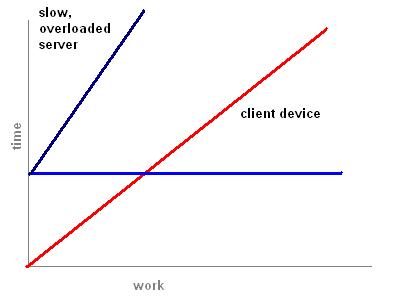This is how I describe the dynamics of cloud computing. The first chart shows the model. The axes are computer workload vs. time to complete a task. The red line is for the client device, which is assumed to be less powerful than the server. The blue line is the latency of the connection to the server, the time it takes to deliver some data request and return a result. For a simple ping, this is of the order of 1/10 of a second or less, depending on traffic. Adding more data will increase the time as bandwidth is limited, which is why those Google maps can take forever to load on a smart phone over the cell network. The dark blue line is the total time for a request adding in the server's more powerful processing speed.
At point P0 is the break-even time. Tasks that take less work than this should be handled by the client device, while ones longer than this may be handled more effectively by the server, assuming the service wants to offer the shortest response time.
The next chart shows the effect of different clients. A PC is faster than a smart phone, so the break-even point is shifted to the left with a lower powered device. This means that more processing should be handled by the servers.
The third chart shows the effect of lower latency. If you could make the connection faster, again the server should take more load. In practice, the latency is mostly due to bandwidth limitations as data is moved between local device and server. Increasing bandwidth therefore makes servers more attractive.
The fourth chart shows two extremes. The vertical orange line is for a dumb terminal that cannot do any processing. This isn’t an obsolete idea. Ultra thin clients might want to have no processing at all, e.g. to display signs, or just may want to prevent any processing at all. You can do this with your browser by turning off Java and Javascript.
The horizontal green line assumes that the server is infinitely scalable, rather like Google’s search engine. In this case, almost any task is computable in a short time.
So what does this tell us about the future? Firstly we know that the fastest growing market is the mobile market, whether smart phones or the new net books. This suggests that the drive to increase server processing in the cloud is going to increase dramatically. Desktop PCs and workstations however, will not likely benefit from the cloud doing the processing, so we can expect big applications to remain installed on the local machine and using the cloud simply for delivery of updates to the software.The war over bandwidth pricing implies that the providers will effectively keep bandwidth low and rates high, shifting the break-even to more local processing and hence driving up the demand for more powerful local devices. This will tend to stifle the growth of ultra thin client devices if unchecked.
For me, the interesting story is what happens if we can build extremely powerful servers, able to deliver a lot of coordinated processing speed to a task. In this case is may make a lot of sense to offload processing to the server like we do with search. One way to think about this is with the familiar calculator widget. Simple 4 function or scientific calculators can easily compute on the client, so the calculator is an installed application.
But what if you want to compute hard stuff, maybe whether a large number is prime? Then it makes sense to use the server as the task can be made easily parallel across many machines and the result returned very quickly indeed. Now the calculator will have more functionality, doing lightweight calculations locally and the heavyweight ones on the server. This approach applies to a lot of tasks that are being thought of today and is driving the demand for both platforms and software languages that can make this very easy to achieve.
Finally, let's look at a case where the server is slower than the client. There is no break-even point because the client device is always faster than the server.
This scenario of the early days of the networked personal computer. Those were the days when networks were slow and servers, if they existed, were mostly simple file servers. It was also characterized by the period of extremely low bandwidth modems, preventing any reasonably fast computational turnarounds. In that world, it made sense to distribute software in boxes and install it on the client. This is still the dominant paradigm, even today, but it is clear that the advent of server farms and broadband, plus the demand for more lightweight mobile devices, will drive the cloud computing paradigm.
Stay tuned...





1 comment:
Clear and useful. Thanks for it.
Post a Comment